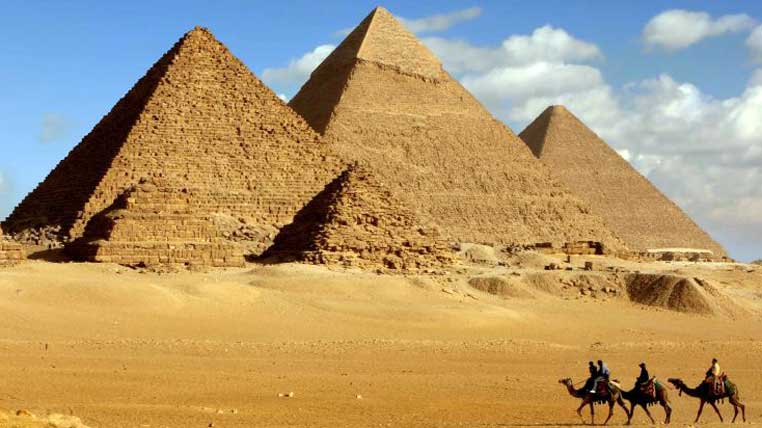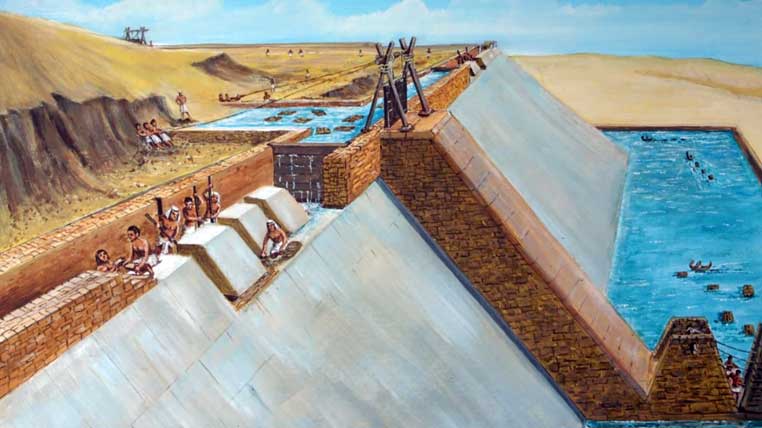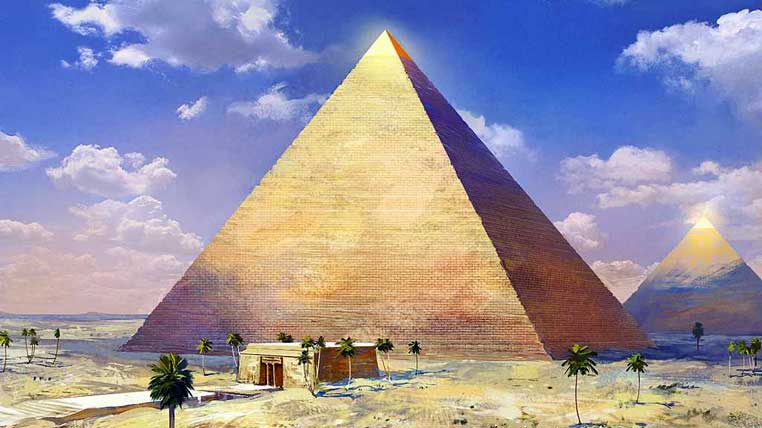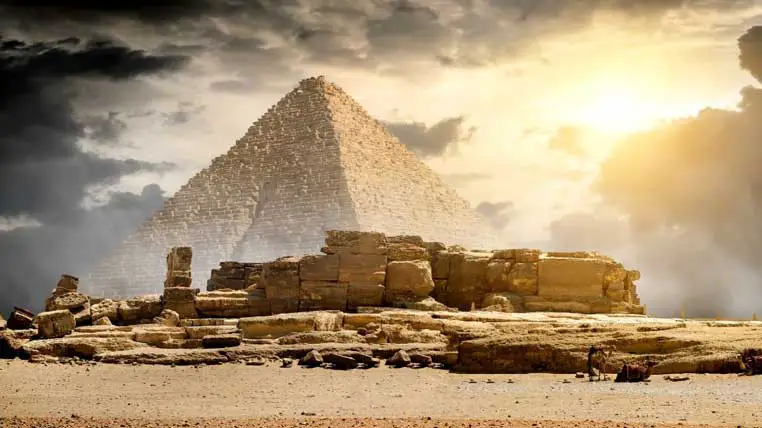The Great Pyramid of Giza is in the Pyramid Fields, part of the Memphis and its Necropolis UNESCO World Heritage Site located in Giza, Egypt.
The Great Pyramid of Giza is a remarkable ancient Egyptian structure, serving as the final resting place of Fourth Dynasty pharaoh Khufu.
Khufu, the second Pharaoh of the Fourth Dynasty, inherited the throne before he turned thirty and immediately began constructing his tomb, which would become the first pyramid at Giza.
According to experts, the pyramid was built over a period of approximately 27 years in the early 26th century BC.
This iconic monument is the oldest of the Seven Wonders of the Ancient World and is the only one that remains mostly intact today.
The Last Standing Wonder of the Ancient World
In the fifth century BC, the Greek historian Herodotus (c. 484 – c. 430-420 BC) wrote about the Great Pyramid of Giza. Still, his report was incomplete as the door leading to the pyramid’s interior had been hidden.
Since its discovery, the entrance to the Great Pyramid of Giza has generated as many mysteries as it has solved.
The Great Pyramid of Giza is the largest of the 70 Egyptian pyramids, standing 146 meters tall, with sides of the base approximately 230 meters wide, and covering a surface of nearly 7 hectares.
If the stone blocks that form the pyramid were transformed into cubes with a side of one meter and placed next to each other, they would create a continuous wall nearly 27,000 kilometers long.
It is generally accepted that all three pyramids of Giza, including those of Pharaohs Khafre (Kefren in Greek) and Menkaure (Mikerinos in Greek), were built during the 4th Dynasty of Egypt (2613-2494 BC).
At the time, it was commonplace for a Pharaoh to begin building a pyramid upon ascending to the throne as a final resting place.
The Great Pyramid of Giza is the largest of all and the only one of the Seven Wonders of the Ancient World that has been preserved.
In fact, the listing of the world’s most outstanding architectural achievements dates back at least to Herodotus, who mentioned such a list.
Later, other Greek historians wrote about the great monuments of their time, and the list of the Seven Wonders of the Ancient World was finalized in the Middle Ages.
Besides the Great Pyramid of Giza, the list of the Seven Wonders of the Ancient World includes the following:
The Hanging Gardens of Babylon: This architectural wonder was part of Nebuchadnezzar II’s palace, constructed around 600 BC. It comprised a series of terraces supported by stone arches, filled with lush vegetation. The ingenious tunnel and pumping system brought water from the nearby Euphrates River to sustain the gardens.
The Temple of Artemis at Ephesus: Located in Asia Minor, this temple was built in 365 BC on a marshy ground that previously housed several earlier temples. Unfortunately, it was destroyed by the Goths in 262 AD.
The Statue of Zeus: Created by the renowned Greek sculptor Phidias in the mid-5th century BC, this masterpiece resided in the temple of Zeus at Olympia, Greece.
The Mausoleum at Halicarnassus: This impressive structure was built around 353 BC and served as the final resting place of King Mausolus of Caria in Asia Minor. However, it was damaged by an earthquake, and its marble was later used in fortifying a castle during the Middle Ages.
The Colossus of Rhodes: Erected around 280 BC, this imposing bronze statue depicted the Greek god Helios, standing over 30 meters tall. Its purpose was to guard the entrance to the main port of the Mediterranean island of Rhodes. Unfortunately, it was destroyed 55 years later.
The Lighthouse of Alexandria: Built in around 280 BC, this naval lighthouse stood on an island in the port of Alexandria, Egypt, and was nearly 150 meters tall, making it the tallest building in the ancient world. However, it was destroyed by earthquakes around 1350.

Construction of the Great Pyramid of Giza
Among the questions related to the pyramids are the source of the rock, which totaled over 11 million cubic meters, the methods by which it was transported, the topographical techniques used to ensure a perfectly flat surface for the pyramid, and the mobilization, housing, and feeding of the armies of workers necessary to erect such extraordinary monuments.
One theory suggests that the pyramid was a vast sundial and astronomical observatory. At the same time, another proposes that it was a secret temple where rituals were practiced to transform new leaders into kings-gods.
However, its mathematical precision makes the Great Pyramid of Giza genuinely remarkable.
Many of the pyramid’s features are based on mathematical relationships, adding to this impressive construction’s mystery.
Site Preparation
The pyramid is built on a hillock cut into steps, leaving only a strip around the perimeter leveled to within 21 millimeters of flatness. The bedrock height reaches almost 6 meters above the pyramid base at the location of the Grotto.
A series of holes have been cut into the bedrock along the sides of the base platform, hypothesized by Mark Lehner (an associate professor of archaeology at the Oriental Institute of the University of Chicago and the Harvard Semitic Museum, who first arrived in Egypt in the 1970s) to have held wooden posts used for alignment.
The English egyptologist and curator I. E. S. Edwards suggests the possibility of using water to even the base, though its practicality remains unclear.
The Ramp Theory
Assuming that the Great Pyramid of Giza at Giza, like other pyramids in Egypt, was built from the ground up, engineers have theorized that numerous scaffolds would have had to be installed as the structure rose.
Using water as a lubricant, workers would push the stone blocks up the ramps and then install them in place.
So, is the ramp theory valid in the case of the Great Pyramid of Giza?
The ramp theory is popular, considering that 96% of the total mass of the Great Pyramid of Giza is located in two-thirds of the structure’s base. By using ramps, the work was actually made easier as the pyramid rose.
In the 1990s, archaeologists Mark Lehner and Zahi Hawass (b. 1947) developed the theory that building the pyramid would not have required 100,000 people, as Herodotus wrote, but rather a much smaller number of skilled workers who worked year-round, with thousands of other workers joining them near the end of summer and in the autumn months when the Nile flooded and watered the agricultural lands.
When the annual flood occurred, farmers and villagers would leave their fields to work on the great pyramid of the king-god.
Lehner and Hawass’ teams found the remains of bakeries and buildings where the fish used to feed the labor force were processed. They also uncovered veal bones and evidence that grains were brought in and not processed on-site.
Initially, it was believed that only the rich could afford choice dishes such as veal. However, evidence has been found that the permanent teams of workers could also enjoy the best foods and grains as a reward for their skill in raising the pyramids.
In 1997, the foundations of several rooms were discovered. Craft workshops were also found alongside the discovery of other bakeries and molds used to prepare bread.
A retaining wall led to another complex of buildings where, on a wall, a seal depicting probably Pharaoh Khafre (2558-2532 BC) was discovered.
In July 2000, two miniature replicas of the pyramids were discovered between the Sphinx and the pyramids. These replicas housed the mummies of overseers and workers at the pyramids.
“And even ordinary people were allowed to use the pyramid model to make their tombs,” concluded Hawass, the Egyptian Museum of Antiquities director.
The inscriptions on the miniature pyramids identified one of the mummies as an inspector of construction.
The upper level of the necropolises was reserved for technicians and craftsmen, while the lower level housed the workers’ bodies.
Some of the bodies showed evidence of splints used to heal broken bones.
Among the inscriptions were also curses, and some frescoes showed workers in full activity. “Such care could not have been provided to slaves,” remarked Hawass.
Materials
The Great Pyramid of Giza is constructed of an estimated 2.3 million blocks, made up of around 5.5 million tonnes of limestone, 8,000 tonnes of granite, and 500,000 tonnes of mortar.
Most of the blocks were quarried at Giza, an area known as the Central Field, just south of the pyramid.
The blocks are made of a particular type of nummulitic limestone formed from the fossils of prehistoric shell creatures, with small disc forms still visible in some of the pyramid’s blocks upon close inspection.
Other fossils, including fossilized shark teeth, have also been found in the blocks and other structures on the site.
The white limestone used for the casing was transported by boat across the Nile from the Tura quarries in the Eastern Desert plateau, about 10 km (6.2 mi) to the southeast of the Giza plateau.
In 2013, rolls of papyrus known as the Diary of Merer were discovered, detailing the deliveries of limestone and other construction materials from Tura to Giza in the 27th year of Khufu’s reign.
The granite stones used in the pyramid were transported from Aswan, more than 900 km (560 mi) south.
The largest blocks, weighing between 25 to 80 tonnes, form the ceilings of the “King’s chamber” and the “relieving chambers” above it.
Ancient Egyptians cut the stone into rough blocks by hammering grooves into natural stone faces and inserting wooden wedges, which were then soaked with water.
The wedges expanded as the water was absorbed, breaking off workable chunks. Once the blocks were cut, they were carried by boat on the Nile River to the pyramid.
Workforce
The Greeks believed that slave labor was used to build the Great Pyramid of Giza. Still, modern discoveries at nearby workers’ camps associated with the construction of Giza suggest that it was built by thousands of conscript laborers.
Worker graffiti found at Giza indicates that haulers were divided into groups of 40 men, known as zau (singular za), consisting of four sub-units, each with an “Overseer of Ten.”
To answer the question of how over two million blocks could have been cut within Khufu’s lifetime, stonemason Franck Burgos conducted an archaeological experiment based on an abandoned quarry of Khufu discovered in 2017.
Within it, an almost completed block and the tools used for cutting it had been uncovered, including hardened arsenic copper chisels, wooden mallets, ropes, and stone tools.
In the experiment, replicas of these tools were used to cut a block weighing about 2.5 tonnes (the average block size used for the Great Pyramid of Giza).
It took four workers 4 days, with each working 6 hours a day, to excavate it.
The progress initially was slow, but it sped up six times when the stone was wetted with water. Based on the data, Burgos extrapolates that about 3,500 quarrymen could have produced the 250 blocks/day needed to complete the Great Pyramid of Giza in 27 years.
Surveys and design
Egyptologist Flinders Petrie made the first precise measurements of the pyramid in 1880–1882, published as The Pyramids and Temples of Gizeh.
The casing stones and inner chamber blocks of the Great Pyramid of Giza fit together with high precision, with joints only 0.5 millimeters wide on average.
However, the core blocks were roughly shaped, with rubble inserted between larger gaps, and mortar was used to bind the outer layers together and fill gaps and joints.
The block height and weight decrease towards the top, with the lowest layer measuring 148 centimeters high and the upper layers barely exceeding 50 centimeters.
The pyramid’s perimeter is highly accurate, with the four sides of the base having an average error of only 58 millimeters in length and a mean corner error of only 12 seconds of arc.
The design dimensions were initially measured to be 280 royal cubits high and 440 cubits long at each of the four sides of its base, with a seked of 5+1/2 palms chosen to describe slopes.

The Great Pyramid of Giza Was Built with Mathematic Precision
Some Egyptologists suggest that the slope was chosen because the ratio of perimeter to height equals 2π to an accuracy of better than 0.05 percent, corresponding to the well-known approximation of π as of today.
π (pi) is a mathematical constant that represents the ratio of the circumference of a circle to its diameter. It is an irrational number, which means it cannot be expressed as a finite decimal or fraction. Its decimal representation is infinite and non-repeating, usually approximated to 3.14159.
Pi is a fundamental constant that appears in many areas of mathematics and science, including geometry, trigonometry, calculus, physics, and engineering. It is used to calculate the area and circumference of circles and the volume and surface area of spheres, cylinders, and cones.
Pi has been known for thousands of years, with ancient civilizations such as the Babylonians and Egyptians approximating its value.
The symbol π was first used by the Welsh mathematician William Jones in 1706, and it has since become one of the world’s most important and well-known mathematical constants.
John Taylor, a British editor and erudite scholar of the Egyptian civilization, discovered a formula by which dividing the length of the perimeter of the Great Pyramid of Giza by twice its height yielded the numerical equivalent of π.
This remarkable feat demonstrates the Egyptians’ advanced knowledge of mathematics and engineering.
Taylor proposed that the Egyptians knew the formula for π thousands of years before the Greeks and the circumference of the Earth, which they used to derive their standard units of measurement.
According to Taylor, the ratio of the height of the pyramid to its perimeter was the same as that between the polar radius and the circumference of the planet—2π. He believed that the pyramid’s formula was an expression of the wisdom of the ancients.
Taylor concluded that the builders of the pyramids had been instructed by the Biblical God, just as Noah had been taught to build the Ark.
Astronomer Charles Piazzi Smyth studied the pyramids and made an astonishing discovery, which he described in his work, Our Inheritance in the Great Pyramid (1980).
He claimed that the Great Pyramid of Giza was an expression of time.
In his studies, Smyth proposed a unit of measurement called the pyramid inch, which was one-thousandth of an Anglo-Saxon inch. The pyramid’s perimeter, measured in pyramid inches, was 365,200, or 1000 x 365.2.
This figure represents the number of days in a year, and Smyth concluded that the pyramid expressed a time interval of one thousand years.
In 1894, J. Norman Lockyer (1836-1920), director of the Solar Physics Observatory in London and founder of the journal Nature, published The Dawn of Astrology.
Based on his investigations, Lockyer claimed that the ancient temples and monuments in Egypt were oriented in such a way as to facilitate stellar observations and served as calendars, such as determining the summer solstice.

The Great Pyramid of Giza: Proof of Advanced Ancient Egyptian Astronomical Knowledge?
Centuries ago, Roman and Arab historians noted the Egyptians’ interest in studying the sky and the possible use of pyramids as astronomical instruments.
Egyptian hieroglyphs make numerous references to stars. A constellation called Sahu, which corresponds to Orion, was named the House of the Dead.
Two pharaohs who built pyramids outside the Giza plateau had stellar associations in hieroglyphs (Nebka is “a star,” and Djedefra is “a star of Sehetu” or a star of Sahu).
In the 9th century, Caliph Abdullah Al Mamun believed that Khufu’s pyramid at Giza housed astronomical maps, mathematical tables, and treasures.
In 820, Abdullah Al Mamun successfully entered the pyramid after breaking several stone slabs.
After heating the limestone bricks, the workers sprayed them with cold vinegar, causing cracks in the pyramid that allowed the caliph’s men to break a wall and discover a tunnel that went up to the pyramid’s original entrance.
On their return, they descended until they found rooms identified as the king’s and queen’s chambers. They found an elaborate sarcophagus in the first room, but nobody was inside, as if it had never been used.
The tombs had either been looted or were intentionally made to deceive, with the mummies and pharaohs’ treasures being in another part of the pyramid.
The mystery of the missing bodies and treasures continues to puzzle the scientific world today.
The bodies of the Pharaohs and their wives may still be buried somewhere in the pyramids, or it’s possible that their earthly remains were looted by thieves, a crime so old it’s mentioned in both Egyptian texts and papyri dating centuries before Herodotus’ description.
Subsequent discoveries and theories, especially those made in the 20th century, confirm Khufu’s pyramid’s astronomical and calendar purposes in Giza.
In the 9th century, Abdullah Al Mamun discovered a tunnel that could have functioned as a stationary telescope for astronomical observations. The downward angle of the tunnel allowed ancient astronomers to observe the evolution of stars in the night sky.
Additionally, two narrow shafts, previously considered ventilation systems for the pyramid, had an astronomical function.
Astronomy expert Virginia Trimble calculated that one of the shafts indicated the North Star, which the Egyptians could have used to determine the true north.
The other shaft was permanently opened to observe the position in the sky of the constellation Orion (Sehu) between 3000 and 2400 BC.
Such discoveries and references have contributed to the theory proposed by Robert Bauval and Adrian Gilbert in their book, The Orion Mystery (1994).
The authors noted that the third pyramid at Giza, the smallest of the three, is detached from the other two. They found a similarity in comparing the pyramids’ alignment with that of the three stars in the Orion constellation.
Bauval and Gilbert suggested that the other two pyramids, along with the pyramids of Nebka and Djedefra, form a pattern of five pyramids following the outline of five of the seven stars of the Orion constellation.
At Ancient Theory we only use trusted sources to document our articles. Such relevant sources include authentic documents, newspaper and magazine articles, established authors, or reputable websites.
- L. Sprague De Camp - The Ancient Engineers. Barnes & Noble, New York, 1993.
- Hames Harpur and Jennifer Westwood - The Atlas of Legendary Places. Konecky & Konecky, New York, 1997.
- H. R. Hays - In the Beginnings. G. P. Putnam’s Sons, New York, 1963.
- Brian Handwerk - Pyramids at Giza. nationalgeographic.com.
- Egyptian Pyramids - history.com. [Source]
- Michael Slackman - In the Shadow of a Long Past, Patiently Awaiting the Future. nytimes.com.
- Mark Lehner - The Complete Pyramids. Thames and Hudson, 2008.
- New discovery throws light on mystery of pyramids' construction. theguardian.com.
- Maria Temming - Scientists detect mystery void in Great Pyramid of Giza. snexplores.org.
- Callum Hoare - Egypt mystery solved: Great Pyramid's secret alignment exposed after 'flaw' spotted. [Source]






